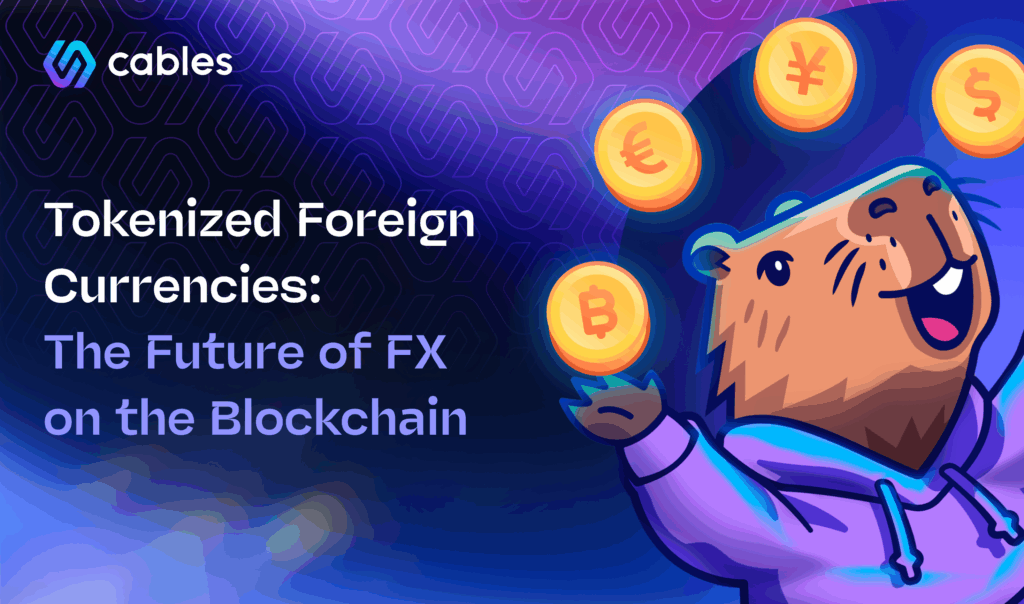Summarize with AI:
Tokenized foreign currencies are blockchain-based representations of traditional fiat like the euro or yen. They enable onchain utility, passive yield, and access to global markets – all without relying on banks or USD-centric infrastructure.
Tokenized Foreign Currencies: The Future of FX on the Blockchain
Foreign exchange (FX) is one of the largest and most liquid markets in the world, with over $7 trillion traded daily. Despite its size, it remains largely disconnected from blockchain-based finance. As decentralized finance (DeFi) grows, there’s increasing interest in bringing traditional currency markets onchain through tokenized foreign currencies. This shift could reshape how capital moves, how users access yield, and how global markets connect.
What Are Tokenized Foreign Currencies?
Tokenized foreign currencies are digital representations of fiat currencies issued on a blockchain. They’re backed by real-world value and designed to track the price of their corresponding currency. These assets bring traditional monetary systems into decentralized environments where they can be transferred, held, and utilized like native crypto assets.
Popular Examples
- Tokenized euro (e.g., EURC)
- Tokenized yen (e.g., JPYC)
- Tokenized Swiss franc, pound, and other G10 currencies
These tokens are typically collateralized either by fiat reserves or by hedging strategies that replicate the value of the underlying currency. Depending on the structure, they can be custodial, synthetic, or hybrid in nature.
Why Tokenize Global Currencies?
Tokenizing global currencies gives users access to international value onchain. For years, DeFi has been dollar-dominated, but global users increasingly want access to local currency-denominated value.
Benefits of Tokenizing FX
Tokenized foreign currencies provide access to non-USD yields and open up new ways for users to hedge currency risk. They allow for truly global onchain transactions and expand the use of DeFi beyond a US-centric audience. As more currencies come onchain, new markets emerge, giving users and developers alike more flexibility in how they interact with and deploy capital. Not to mention, it allows traders to trade FX without any time-bound traditional constraints, like only during certain market hours.
These currencies create FX rails on blockchain networks that allow exposure without the need for foreign bank accounts or traditional infrastructure. For businesses and institutions, tokenized FX provides an opportunity to settle payments, optimize treasury management, and rebalance portfolios across borders — all while staying entirely onchain.
Where DeFi Meets FX
Tokenized FX creates a new layer of functionality within DeFi. By using blockchain infrastructure, users can settle trades instantly, access transparent pricing, and interact with non-USD assets without needing permissioned intermediaries.
What makes this more than a simple wrapper is the potential for integration. Once tokenized, currencies can plug into staking platforms, yield farms, lending protocols, and onchain treasuries. That means value can flow, earn, and interact with the broader ecosystem — not sit idle.
Where Can You Trade FX Onchain Today?
While tokenized currencies have grown in visibility, active trading venues for onchain FX remain limited. A few protocols currently offer partial access to non-USD currencies:
Curve Finance supports several FX-stablecoin pools, such as EURC and agEUR, enabling basic swaps between stable foreign currencies. These pools are useful but typically offer lower liquidity and limited integrations across DeFi.
Uniswap and other AMMs occasionally host FX-denominated trading pairs. However, these tend to be fragmented, thinly traded, and inconsistent depending on demand.
Pendle and Ethena offer synthetic ways to gain foreign currency exposure through yield-bearing assets and basis trades. These approaches mimic FX outcomes, but aren’t directly tied to tokenized currencies.
Cables is building a more unified system focused specifically on tokenized FX. With cabTokens like cabEUR and cabJPY launching soon, the platform will allow users to stake and earn yield on FX assets, with a native marketplace and ecosystem designed for real utility and composability.
What’s Still Missing?
While the concept of tokenized FX is gaining traction, utility remains limited. Many existing assets serve as simple representations of foreign currencies but lack built-in yield, ecosystem integration, or tools for composability. In their current form, these tokens are underused and often sit idle in wallets.
The next step is building systems where these assets can be staked, swapped, or used as collateral. That means developing yield mechanics, asset-specific infrastructure, and incentives for onchain participation. It also requires transparent mechanisms for tracking FX peg maintenance, pricing feeds, and collateral backing to build trust at scale.
A Multi-Currency Future
Tokenized FX opens the door to a more diverse, currency-inclusive onchain world. As protocols develop systems that treat these assets as usable primitives, global capital can move more freely between platforms and networks. This shift supports use cases like treasury diversification, cross-border payments, and user-facing products built around local currencies.
As more real-world currencies go onchain, the FX market itself becomes more accessible, and not through intermediaries, but through DeFi-native tools that allow users to hold, deploy, and earn on currencies they understand.
How Cables Is Approaching Tokenized FX
Cables is building infrastructure designed to activate tokenized foreign currencies. Rather than simply offering representations of global currencies, Cables focuses on utility.
cabTokens – including cabEUR and cabJPY – are yield-bearing assets backed by institutional hedging strategies and active participation mechanics. Users will be able to stake them, earn yield, and move across the Cables ecosystem while maintaining currency exposure.
This makes tokenized FX functional. It isn’t simple an asset held in a wallet, it becomes productive capital.
Conclusion
Tokenized foreign currencies are shaping the next generation of onchain finance. By making global currencies accessible, yield-bearing, and usable, protocols like Cables are expanding what’s possible in crypto. The FX market is massive. Bringing it onchain, currency by currency, is the next chapter
Share this article:


